Citroën 2CV
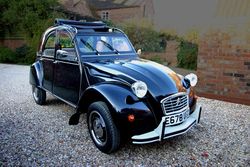 |
|
| Manufacturer | Citroën |
|---|---|
| Production | 1948—1990 [1] |
| Assembly | Forest/Vorst, Belgium Liège, Belgium Slough, UK Brandsen, Buenos Aires, Argentina Arica, Chile Mangualde, Portugal Paris, France Vigo, Spain |
| Class | Economy car |
| Body style(s) | 2-door panel van 2-door truck 4-door landaulet |
| Layout | Front engine, front-wheel drive / four-wheel drive |
| Engine(s) | 375 cc H2 air cooled 425 cc H2 air cooled 435 cc H2 air cooled 602 cc H2 air cooled |
| Transmission(s) | 4-speed manual |
| Wheelbase | 2.40 metres (94.5 in) |
| Length | 3.83 metres (150.8 in) |
| Width | 1.48 metres (58.3 in) |
| Height | 1.60 metres (63.0 in) |
| Curb weight | 560 kg (1,200 lb) |
| Related | Citroën Dyane Citroën FAF Citroën Méhari Citroën Ami Citroën Bijou |
| Designer | Flaminio Bertoni |
The Citroën 2CV (French: “deux chevaux” i.e. “deux chevaux vapeur”, literally “two tax horsepower”) was an economy car produced by the French automaker Citroën from 1948-1990.[1] It was technologically advanced and innovative, but with uncompromisingly utilitarian unconventional looks, and deceptively simple Bauhaus inspired bodywork, that belied the sheer quality of its underlying engineering. It was designed to move the French peasantry on from horses and carts. It is considered one of Citroën's most iconic cars. In 1953, 'Autocar' in a technical review of the car wrote of, "...the extraordinary ingenuity of this design, which is undoubtedly the most original since the Model T Ford."[2] It was described by CAR magazine journalist and author LJK Setright as "the most intelligent application of minimalism ever to succeed as a car."[3] It was designed for low cost, simplicity of use, versatility, reliability, and off-road driving. For this it had a light, easily serviceable engine, extremely soft long travel suspension (with adjustable ride height), high ground clearance, and for oversized loads a car-wide canvas sunroof (which until 1960 also covered the boot).
During a production run of 42 years between 1948 and 1990, 3,872,583 2CVs were produced, plus 1,246,306 camionnettes (small 2CV trucks), as well as spawning mechanically identical vehicles like the Ami — 1,840,396, Dyane — 1,444,583, Acadiane — 253,393, and Mehari — 144,953: a grand total of 8,756,688.
From 1988 onwards, production took place in Portugal rather than in France. This arrangement lasted for two years until 2CV production halted. Portuguese built cars, especially those from when production was winding down, have a reputation in the UK for being much less well made and more prone to corrosion than French built.[4][5][6]
Contents |
History
The 2CV belongs to a very short list of vehicles introduced in the middle of the twentieth century that remained relevant and competitive for many decades, such as the Jeep, Land Rover Series, Fiat 500, Austin Mini and Volkswagen Beetle. The 2CV would be produced for some 42 years with minimal design changes.

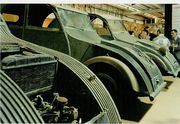
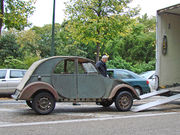
Pierre-Jules Boulanger's early 1930s design brief, (after a pioneering market research survey done by Jacques Duclos), was to be astonishingly radical for the time, was for a low-priced, rugged "umbrella on four wheels" that would enable two peasants to drive 100 kg (220 lb) of farm goods to market at 60 km/h (37 mph), in clogs and across muddy unpaved roads if necessary. France at that time had a very large rural population, who had not yet adopted the automobile, due to its cost. The car would use no more than 3 L of gasoline to travel 100 km (78 MPG). Most famously, it would be able to drive across a ploughed field without breaking the eggs it was carrying. Boulanger later also had the roof raised to allow him to drive while wearing a hat.
André Lefèbvre was the engineer in charge of the TPV (Toute Petite Voiture—"Very Small Car") project. By 1939, the TPV was deemed ready and several prototypes had been built. Those prototypes made use of aluminium and magnesium parts and had water-cooled engines. The seats were hammocks suspended from the roof by wires.
During the German occupation of France during World War II, Michelin (Citroën's main shareholder) and Citroën managers decided to hide the TPV project from the Nazis, fearing some military application. Several TPVs were buried at secret locations, one was disguised as a pickup, and the others were destroyed, and Boulanger had the next six years to think about more improvements. Until 1994, when three TPVs were discovered in a barn, it was believed that only two prototypes had survived. As of 2003, five TPVs are known. For long, it was believed that the project was so well hidden that all the prototypes had been lost at the end of the war. It seems that none of the hidden TPVs was lost after the war, but in the 1950s an internal memo ordered them to be scrapped. The surviving TPVs were, in fact, hidden from the top management by some workers who were sensitive to their historical value.
After the war, internal reports at Citroën showed that producing the TPV would not be economically viable, given the rising cost of aluminium in the post-war economy. A decision was made to replace most of the aluminium parts with steel parts. Other changes were made, the most notable being an air-cooled engine, new seats and a restyling of the body by the Italian Flaminio Bertoni. It took three years for Citroën to rework the TPV and the car was nicknamed "Toujours Pas Vue" (Still Not Seen) by the press.
Citroën finally unveiled the car at the Paris Salon of 1948.[7] The car on display was nearly identical to the 2CV type A that would be sold next year, but lacked an electric starter, the addition of which was decided the day before the opening of the Salon. The car was heavily criticised by the motoring press and became the butt of French comedians for a short while.[2] One American motoring journalist quipped, "Does it come with a can opener?".[8] The British 'Autocar' correspondent said that the 2CV, "...is the work of a designer who has kissed the lash of austerity with almost masochistic fervour."[9] Nevertheless, Citroën were flooded with orders at the show, and it had a great impact on the low-income segment of the population in France.
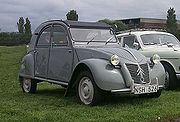
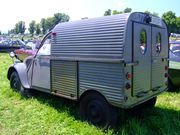
The 2CV was a great commercial success: within months after it went on sale, there was a three-year waiting list. The waiting list was soon increased to five years. At that time a second-hand 2CV was more expensive than a new one because the buyer did not have to wait.[2] Production was increased from four units per day in 1949 to 400 units per day in 1950. Grudging respect began to emanate from the international press: towards the end of 1951 the opinion appeared in Germany's recently launched Auto Motor und Sport magazine that despite its "ugliness and primitiveness" ("Häßlichkeit und Primitivität"), the 2CV was a "highly interesting" ("hochinteressantes") car.[10]
In 1951, Citroën introduced the 2CV Fourgonnette van. It pioneered the use of a large box rear section, as later used by the Morris Minor, Renault 4, Citroën Acadiane and Citroën C15 vans and copied in the 1990s by Vauxhall/Opel and Ford. The "Weekend" version of the van had collapsible, removable rear seating and rear side windows, enabling a tradesman to use it as a family vehicle at the weekend as well as for business in the week. This was the fore-runner of the Citroën Berlingo and Renault Kangoo people carriers introduced in the 1990s. A pick-up truck version was used by the British Royal Navy for pioneering Royal Marine helicopter carrier amphibious operations aboard HMS Bulwark and Albion, in the late 1950s and early 1960s, due to the payload limitations of their first large helicopters.[11]

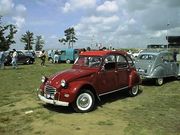
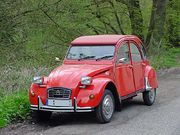

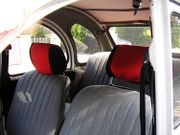

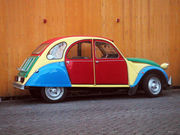
A special version of the 2CV was the Sahara for very difficult off-road driving, built from December 1960-1971. This had an extra engine mounted in the rear compartment and both front and rear wheel traction. Only 694 Saharas were built. The target markets for this car were French oil companies, the military, and the police.
In 1960, the 2CV was updated, and looked similar until the end of production. In particular the corrugated Citroën H Van style "ripple bonnet" of convex swages was replaced (except for the Sahara), with one using six larger concave swages. The 1960s were the heyday of the 2CV, when production finally caught up with demand.[12]
In 1967, Citroën launched a new model based on the 2CV chassis, with an updated but still utilitarian body, with a hatchback that boosted practicality: the Citroën Dyane. This was in response to the direct competition by the Renault 4, that had used so many stolen design ideas from the 2CV and Traction Avant that Citroën contemplated legal action at the time of its launch. (Similarly, Volkswagen had had to pay damages to Hans Ledwinka over the Beetle in the 1960s.) At the same time, Citroën developed the Méhari off-roader.
The purchase price of the 2CV was always very low. In Germany in the 1960s, for example, it cost about half as much as a Volkswagen Beetle.
In 1970, the flat-2 engine size was increased to 602 cc (36.7 cu in) and the car gained rear light units from the Citroën Ami 6, and also standardised a third side window in the rear pillar on 2CV6 (602 cc) models. All 2CVs from this date can run on unleaded fuel. 1970s cars featured rectangular headlights.
The highest annual production was in 1974. Sales of the 2CV were reinvigorated by the 1974 oil crisis. The 2CV after this time became more of a youth lifestyle statement than a basic functional form of transport. This renewed popularity was encouraged by the Citroën "Raid" intercontinental endurance rallies of the 1970s where customers could participate by buying a new 2CV, fitted with a ruggedising kit to cope with thousands of miles of very poor or off-road routes. The Paris to Persepolis rallye was the most famous.[13] The Citroën "2CV Cross" circuit / off-road races were very popular in Europe.
In 1981, a bright yellow 2CV was driven by James Bond in the film For Your Eyes Only, including an elaborate set piece car chase through a Spanish olive farm, in which Bond uses the unique abilities of the modestly powered 2CV to escape his pursuers in Peugeot 504 sedans. The car in the film was fitted with the flat-4 engine from a Citroën GS for slightly more power.[14] Citroën launched a special edition 2CV "007" to coincide with the 2CV product placement in the film, it was fitted with the standard flat-2 engine, painted in yellow with "007" on the front doors and fake bullet hole stickers. This car was also popular in miniature, from Corgi Toys.
Special Edition Saloon Models
The special edition models, that started with the 1976 SPOT model continued in the 1980s:
- 1979/1981 Charleston — inspired by Art-Deco style 1920s Citroën model colour schemes.
- 1981 007 — in association with the James Bond film For Your Eyes Only.
- 1983 Beachcomber — known as 'France 3' in France or 'Transat' in other continental European markets — Citroën sponsored the French Americas Cup yacht entry of that year.
- 1985 Dolly.
- 1986 Cocorico — supporting France in the 1986 Football World Cup.
- 1987 Bamboo.
- 1988 Perrier — in association with the mineral water company.
The Charleston became a full model in 1981 and the Dolly in 1985. All the special editions made a virtue of the individual anachronistic styling. The changes between the special editions and the basic "Spécial" base model, (that was also continued until the end of production), were only a different speedometer, paint, stickers, seat fabric, internal door handles, and interior light. Many of the "special edition" interior trim items were carry-overs from the 1970s "Club" models. Citroën probably gained former VW customers as the only other "retro alternative" economy car style of vehicle, the Volkswagen Beetle, was withdrawn from the European market in 1978, (special order only from Mexico in the 1980s), when it ceased production in West Germany.
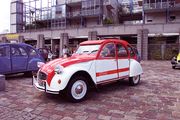
2CV SPOT
|
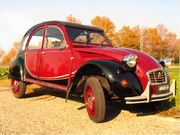
2CV Charleston (Rouge Delage / Noir)
|
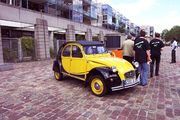
2CV Charleston (Jaune Helios / Noir)
|
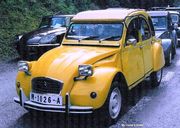
2CV 007
|

2CV Beachcomber
|
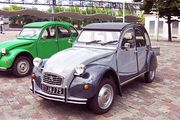
Charleston (Gris Cormoran / Nocturne)
|

Citroën 2CV Dolly
|
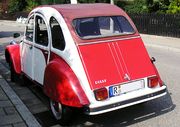
Citroën 2CV Dolly from behind
|
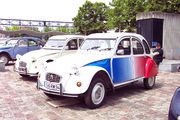
2CV Cocorico
|
|
Citroën 2CV Bamboo
|
Picture of 2CV Perrier needed |
The 2CV in export markets
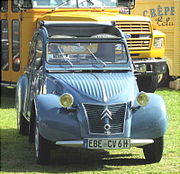

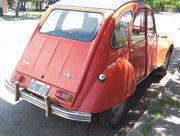
The 2CV was mainly sold in France and some European markets. In the post-war years, Citroën was very focused on the home market, which had some unusual quirks, like puissance fiscale. The management of Michelin was supportive of Citroën up to a point, and with a suspension designed to use Michelin's new radial tyres the Citroën cars clearly demonstrated their superiority over their competitors' tyres. But they were not prepared to initiate the investment needed for the 2CV (or the Citroën DS for that matter) to truly compete on the global stage. Citroën was always under-capitalised until the 1970s Peugeot takeover. Consequently, the 2CV suffered a similar fate to the Morris Minor and Mini, selling fewer than 10 million units, whereas the Volkswagen Beetle, which was sold worldwide, sold 21 million units.
Some of the early models were built at Citroën's plant in Slough, England in the 1950s, but the 2CV sold poorly in Great Britain in part due to its excessive cost because of import duties on components. Sales of Slough-produced 2CVs ended in 1960. In 1959, trying to boost sales, Citroën introduced a glass-fibre coupé version called the Bijou that was briefly produced at Slough. Styling of this little car was by Peter Kirwan-Taylor (better known for his work with Colin Chapman of Lotus cars), but it proved to be too heavy for the diminutive 425 cc (25.9 cu in) engine to endow it with adequate performance. It served to use up remaining 2CV parts at Slough in the early 1960s. In 1975, the 2CV was re-introduced to the British market in the wake of the oil crisis. These were produced in France but avoided the crippling import duties of the 1950s, because the UK had joined the EEC. In the 1980s, the best foreign markets for the 2CV were the UK and Germany.[15]
Only a few thousand 2CVs were sold in North America when they were new; as in England their pricing was excessive relative to competitors. The original model that produced just 9 hp (6.7 kW) and had a top speed of only 40 mph (64 km/h) (even the fastest of the later models struggled to 70 mph (110 km/h))[16] was unsuited to the expanding post war US freeway network, and was never widely accepted in North America, unlike the Volkswagen Beetle, which was designed with Autobahns in mind and could reach speeds of over 70 mph (and later versions were faster still). Citroën was marketed as a luxury brand after the launch of the mid 1950s Citroën DS in North America, and the importers didn't actively promote the 2CV, as doing so would undermine the brand image. Unlike larger Citroëns, there are no legal issues with owning a 2CV; the car is effectively a restored pre-1968 vehicle. It was one of these vehicles that became the focus of a recent news story, when musician Billy Joel had an accident in his 2CV in 2004, on Long Island, New York.[17] Joel gave another 2CV to his bride Christie Brinkley as a present.
A rare Jeep-esque derivative, called the Yagán[18] after an Aborigine tribe, was made in Chile between 1972 and 1973. After the Chilean coup of 1973, there were 200 Yagáns left that were used by the Army to patrol the streets and the Peruvian border, with 106 mm (4.2 in) cannons.
A similar car was sold in some west African countries as the Citroën "Baby-brousse".[19]
In Iran, the Citroën 2CV was called the Jian.[20] The cars were originally manufactured in Iran in a joint venture between Citroën and Iran National up until the 1979 Revolution, when Iran National was nationalised, which continued producing the Jian without the involvement of Citroën.[21]
The 2CV was built in Chile and Argentina for South America. The 1953 Citroneta model of the 2CV made in Chile and Argentina used a type AZ chassis with 425 cc engine developing 12 bhp (8.9 kW). Both chassis and engine were made in France while the 'three box' bodywork (in both 2- and 4-door versions) was designed and produced in Chile. It was the first economy car on the market in Chile. The 1970s Chilean version mounted a 602 cc engine with an output of 33 hp (25 kW), and was designated as the AX-330. It was built between 1970 and 1978, during which it saw changes like different bumpers, a hard roof, front disc brakes, and square headlights.[22] A derivation called the "3CV" was built in Argentina with various modifications such as a hatchback. Citroën had produced more than 200,000 cars in Argentina by 1977; production ended in 1979 due to the collapse of the Argentinian economy. A 2CV with a heavily modified front end called the 3CV IES America was produced well into the 1980s, by an Argentinian company that bought the rights and factory from Citroën.[23][24]
The 1981 James Bond movie For Your Eyes Only caused a surge in sales of the car in Chile where it was specially imported from Spain to meet demand (mostly in yellow), since it had already been phased out on the Chilean assembly line.
In 1985, Citroën drew up plans with the Escorts Group to manufacture the 2CV in India for the rural market, as well as spares for export. However, the Indian government rejected this scheme as it would have resulted in competition for Maruti in which they held a stake.
Construction
The level of technology in the 1948 2CV was remarkable for a car of any price in that era, let alone one of the cheapest cars on the planet. While colours and detail specifications were modified in the ensuing 42 years, the biggest mechanical change was the addition of front disc brakes in 1981 (from the discontinued Citroën Dyane), for the 1982 model year.

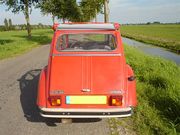
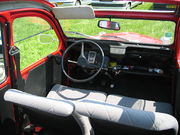

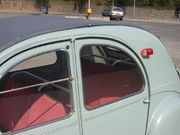
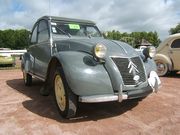
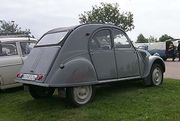
The 1948 2CV featured:
- unusual four wheel independent suspension, front and rear wheels which connected the front and rear suspension on each side
- leading arm front suspension
- trailing arm rear suspension
- rear fender skirts, but the suspension design allowed wheel change without removing the skirts / rear wings
- front-wheel drive
- inboard front brakes, in order to help lower unsprung weight thus making ride even softer
- Four wheel hydraulic brakes, (British Austin economy cars of the time only had hydraulic front brakes, the rears were by mechanical linkage)
- small, lightweight, air-cooled flat twin engine, (with overhead valves when side valves were still common), mounted very low in front of the front wheels for stability
- 4-speed manual transmission, (when three speeds were common) with an unusual dashboard push/pull/twist linkage
- bolt-on detachable front and rear wings/fenders
- detachable doors, bonnet (and boot lid after 1960), by "slide out" P profile sheet metal hinges
- front rear-hinged "suicide doors"
- flap-up windows, as roll up windows were considered too expensive in 1948
- detachable full length fabric sunroof and boot lid, for almost pickup-truck-like load carrying versatility
- rack and pinion steering mounted inside the front suspension cross-tube, well behind the front wheels, away from a frontal impact
- load adjustable headlights.
- a heater (heaters were standardised on British economy cars in the 1960s)
The body was constructed of a dual H-frame platform chassis and aircraft-style tube framework, and a very thin steel shell that was bolted to the chassis. Because the original design brief called for a low speed car, little or no attention was paid to aerodynamics. The result was that the body had a drag coefficient (Cd) of a high 0.51.
The Suspension of the 2CV was almost comically soft; a person could easily rock the car side to side dramatically (back and forth was quite a bit more resistant). The leading arm / trailing arm swinging arm, fore-aft linked suspension system together with inboard front brakes had a much smaller unsprung weight than existing coil spring or leaf spring designs. It was designed by Alphonse Forceau.
- The system comprises two suspension cylinders mounted horizontally on each side of the platform chassis. Inside the cylinders are two springs, one for each wheel, mounted at each end of the cylinder. The springs are connected to the front leading swinging arm and rear trailing swinging arm, that act like bellcranks by pull rods (tie rods). These are connected to spring seating cups in the middle of the cylinder, each spring being compressed independently, against the ends of the cylinder. Pictured in reference.[25]
- If each cylinder was rigidly mounted to the chassis, it would provide fully independent suspension, but it is not rigidly mounted. It is mounted using an additional set of springs, originally made from steel, called "volute" springs, but on later models made from rubber. These springs allow the front and rear suspension to interconnect.
- When the front wheel is deflected up over a bump, the front pull rod compresses the front spring inside the cylinder, against the front of the cylinder. This also compresses the front "volute" spring pulling the whole cylinder forwards. That action pushes the rear wheel down on the same side via the rear spring assembly and pull rod. When the rear wheel meets that bump a moment later, it does the same in reverse, keeping the car level front to rear. When both springs are compressed on one side when travelling around a bend, the equal and opposite forces applied to the front and rear spring assemblies reduce the interconnection significantly. This stiffens the suspension after a certain amount of body roll has been achieved. It allows the 2CV to have very soft "bump mode" absorption, without wallow or uncontrolled float.
- At high angles of body roll, the swinging arms that are mounted with large bearings to "cross tubes" that run side to side across the chassis; combined with the effects of all-independent soft springing and excellent damping, this keeps the road wheels in contact with the road surface and parallel to each other across the axles. This provides excellent road holding, while appearing to look like a softly sprung American car with poor handling and road holding because of poor body control. The other key factor in the quality of its road holding is the very low and forward centre of gravity, provided by the position of the engine and transmission.
- On early cars friction dampers (like a dry version of a multi-plate clutch design) were fitted at the mountings of the front and rear swinging arms to the cross-tubes. Because the rear brakes were outboard, they had extra tuned mass dampers to damp wheel bounce from the extra unsprung mass. Later models had tuned mass dampers at the front (because the leading arm had more inertia and "bump/thump" than the trailing arm), with hydraulic telescopic dampers / shock absorbers front and rear. The uprated hydraulic damping obviated the need for the rear inertia dampers. (It should be noted that only dampers designed to be able to work horizontally should be used as replacements. Some that will physically fit do not work properly horizontally.)
This sophisticated suspension design ensured the road wheels followed ground contours underneath them closely, while insulating the vehicle from shocks, enabling the 2CV to be driven over a ploughed field as its design brief required. More importantly it could comfortably and safely drive at reasonable speed, along the ill-maintained and war-damaged post war French Routes Nationales. It was commonly driven 'Pied au Plancher' - 'foot to the floor' by their peasant owners.[26][27]
The 2CV suspension was assessed by Alec Issigonis and Alex Moulton in the mid-1950s (according to an interview by Moulton with CAR magazine in the late 1990s); this inspired them to design the Hydrolastic suspension system for the Mini and Austin 1100, to try to keep the benefits of the 2CV system but with added roll stiffness in a simplified design.
Front-wheel drive made the car easy and safe to drive and Citroën had developed expertise with it due to the pioneering Traction Avant, which was the first mass produced steel monocoque front wheel drive car in the world. The 2CV was originally equipped with a sliding splined joint, and twin Hookes type universal joints on its driveshafts; later models used constant velocity joints and a sliding splined joint.
It was powered by a flat-twin air-cooled engine designed by Walter Becchia, with a nod to the classic "boxer" BMW motorcycle engine (it is reported that Becchia dismantled the engine of the BMW motorcycle of Flaminio Bertoni before designing the 2CV engine).
The Gearbox was a 4-speed manual transmission, an advanced feature on an inexpensive car at the time. Boulanger had originally insisted on no more than three gears, because he believed that with four ratios the car would be perceived as complex to drive by customers. Thus, the fourth gear was marketed as an overdrive, this is why on the early cars the "4" was replaced by "S" for surmultipliée. The gear shifter came horizontally out of the dashboard with the handle curved upwards. It had a strange shift pattern: the first was back on the left, the second and third were inline, and the fourth (or the S) could be engaged only by turning the lever to the right from the third. Reverse was opposite first. Although this may seem an odd layout, it is in fact logical. The idea is to put most used gears opposite each other: for parking, first and reverse; for normal driving, second and third. This layout was adopted from the H-van's 3-speed gearbox.
In keeping with the ultra-utilitarian (and rural) design brief, the canvas roof could be rolled completely open. The Type A had one stop light, and like the black Ford Model T was available only in one color, grey. Blue was offered in 1959, then yellow in 1960. The windscreen wipers were powered by a purely mechanical system: a cable connected to the transmission; to reduce cost, this cable also powered the speedometer. The wipers' speed was therefore dependent on car speed. When the car was waiting at a crossroad, the wipers were not powered; thus, a handle under the speedometer allowed them to be operated by hand. Although this system was far from perfect, it was better than some 1950s British Ford economy cars that had wipers powered by inlet manifold vacuum, that ran at full speed at engine idle, but slowed down to a crawl when cruising at speed. From 1965, the wipers were powered by a single speed electric motor.
The reliability of the car was increased by the fact that, being air-cooled (with an oil cooler), it had no coolant, radiator, water pump or thermostat. It had no distributor either, just a contact breaker system. Except for the all hydraulic brakes, there were no hydraulic parts on original models as damping was by tuned mass dampers and friction dampers.
Engines

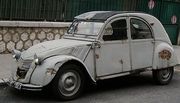
The car featured an air-cooled, flat-twin, four-stroke, 375 cc engine with pushrod operated overhead valves and a hemispherical combustion chamber. The notoriously underpowered earliest model developed only 9 bhp DIN (6.5 kW). A 425 cc engine was introduced in 1955, followed in 1968 by a 602 cc one giving 28 bhp (21 kW) at 7000 rpm. With the 602 cc engine, the tax classification of the car changed so that it became in fact a 3CV, but the commercial name remained unchanged. A 435 cc engine was introduced at the same time in replacement of the 425 cc; the 435 cc engine car was christened 2CV 4 while the 602 cc took the name 2CV 6 (although a variant did take the name 3CV in Argentina). The 602 cc engine evolved to the M28 33 bhp (25 kW) in 1970; this was the most powerful engine fitted to the 2CV. A new 602 cc giving only 29 bhp (22 kW) at a slower 5750 rpm was introduced in 1979. Despite being less powerful, this engine was more efficient, allowing lower fuel consumption and better top speed, at the price of decreased acceleration. All 2CVs with the M28 engine can run on unleaded petrol, but attention is needed to ensure that valve clearances are maintained.
The 2CV also pioneered the use of the now common wasted spark ignition system, also known as the DIS (Distributorless Ignition System) ignition using a double-ended coil firing both spark plugs on each revolution (on the exhaust and compression stroke), by just a contact breaker. This removed the need for a rotor arm in a distributor using high voltage electricity. Arcing problems and insulation breakdown of the rotor and distributor cap, was a significant cause of unreliability in contact breaker (Kettering) ignition systems. Some modern systems like SAABs, take this one step further by using one coil per spark plug mounted on the plug; eliminating high-voltage ignition wires altogether. The 2CVs simplified system only advanced ignition timing with engine speed, by centrifugal weights; it had no vacuum advance unit, to take account of engine load.
The engine's design concentrated on the reduction of moving parts. The cooling fan and dynamo were built integrally with the one-piece crankshaft, removing the need for drive belts. (Late models (shown in photo) used an alternator mounted high above the engine, to keep it dry, run with a drive belt). Instead of using the usual two-piece crank bearings, one-piece items were pressed onto the crankshaft with a hydraulic press once the crankshaft had been submerged in liquid nitrogen to cause it to contract (thus providing enough clearance to press the bearings on). The camshaft drive gears incorporate a spring-loaded split gear, to reduce the effects of gear wear and backlash on valve timing and ignition timing. Similarly, the contact breaker was driven directly off the end of the camshaft, meaning that the ignition timing remained accurate for years, unlike cars with distributors driven by a separate jackshaft that are affected by gear wear and backlash.
These design features made the 2CV engine highly reliable; test engines were run at full speed for 1000 hours at a time, equivalent to driving 50,000 mi (80,000 km) at full throttle. They also meant that the engine was very much "sealed for life" — the main bearings, for example, could not be replaced individually; the entire crankshaft had to be replaced. However, the engine is very under-stressed and long-lived, so this is not a major issue. Until the 1960s it was common for other car manufacturers' engines (British Fords especially) to need full strip downs and rebuilds at as little as 50,000 mi (80,000 km) intervals; un-rebuilt 2CV engines are still running that are passing 250,000 mi (400,000 km).
If the starter motor failed, the 2CV had the option of starting on a starting handle, the jack handle serving as starting handle, by means of dog clutches on the front of the crankshaft, at the centre of the fan. It was a common feature on cars in the 1940s; the 1948 Morris Minor had a hole in its front bumper for the same reason. This feature was kept until the end of production, by which time it was unique.
Performance
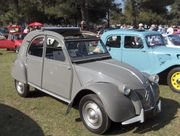
When asked about the 2CVs performance and acceleration, many owners said it went "from 0-60 in one day". Others jokingly said they "had to make an appointment to merge onto an interstate highway system".
The original 1948 model that produced only 9 hp had a top speed of just 40 mph, far below speeds necessary for North American highways or the German Autobahns already existing then. The top speed would increase with engine size to 49 mph in 1955, 52 mph in 1962, 63 mph in 1970, but would not finally be capable of US freeway speeds of 71 mph until 1981.[16]
The last evolution of the 2CV engine was the Citroën Visa flat-2, a 652 cc featuring an electronic ignition. Citroën never sold this engine in the 2CV, however some enthusiasts have converted their 2CVs to 652 engines, or even transplanted Citroën GS or GSA flat 4 engines and gearboxes. Cars with the flat-4 engines and subtle bodywork changes so they appear to be standard are known as "Sidewinders" in the UK.
In the mid 1980s CAR magazine editor Steve Cropley ran a turbocharged 602 cc 2CV that was developed by engineer Richard Wilsher.[28]
Expeditions

The 2CV has also been used for travel around the world. In 1958–1959, two young Frenchmen, Jean-Claude Baudot and Jacques Séguéla started at the Paris Motor Show on October 9, 1958; headed south and crossed the Mediterranean Sea by boat from Port Vendres to Algeria; traversed the African continent and crossed the South Atlantic from Cape Town to Rio de Janeiro; cris-crossed South America and the United States; and boated from San Francisco, California to Yokohama. They returned to Paris on November 11, 1959. During the 13 months, they drove 100,000 kilometres, and consumed 5000 litres of petrol and 36 tires.
Citroën promoted 2CV events called "Raids" in the 1970s and main dealers would supply a ruggedising kit. Paris to Persepolis in Iran was best known.
Nicknames
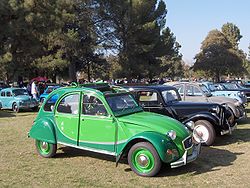
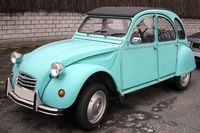
Popular French nicknames were "Deuche" and "Dedeuche". The Dutch were the first to call it "het lelijke eendje" ("the ugly duckling") or just "Eend" ("duck"), while the Flemish called it "de geit" ("the goat"). In German-speaking countries, it is called "Ente" ("duck"). English nicknames include "Tin Snail", "Dolly" and "Upside-down pram". In the former Yugoslavia, the car was called "spaček" (pronounced "spa-check", Slovene for "little freak"). In Spanish-speaking countries, they were nicknamed "dos caballos" (two horses), "citrola", "citruca", "cirila", "la rana" (the frog) and derived from "Citroën" were called "citroneta" and "la cabra"(the goat). In Denmark, the car has many names like "Gyngehest" (Rocking horse) or "Studenter-Jaguar" (student's Jaguar) while amongst 2CV enthusiasts the cars are affectionately called "De kære små" (the dear small ones). In Finland, the 2CV is known as "Rättisitikka" (Finnish for "rag Citroën") because of its canvas roof. In Swedish (at least in the Swedish-speaking areas of Finland), it's called "Lingonplockare" (since the looks are similar to a device for picking lingonberries). In Tunisia, they call it "karkassa". Hungarians call it "Kacsa" (pronounced "kacha" and meaning "duck"). In Israel, it was called "פחנוע" (pronounced "pah-noa", meaning "tin car") and in Iceland it was named "Sítróen braggi" (meaning "Citroën Quonset hut"). In Norway, the name was "Jernseng", meaning "iron bed". In Iran, it is known as "Jian / Zhian ژیان", which means "Fierce". In the U.S., it was known as the "flying rag top". American cartoonist Gilbert Shelton referred to it as the "duh-shuh-vuh", referring to the French pronunciation of "2CV". In Ireland it was noticed as the underdog or íochtarán or it was either called bucket of rust or Buicéad na meirge. This was because most imported cars at the time that come to Ireland would've to wait at the pier or harbour for at least for 3–12 months and especially in Westport, County Mayo where it is well known for its constant rain as the 2cv was very prone to corrosion. Outside France, the 2CV's most common nickname today is "The Duck", which seemed to be endorsed by Citroën which released a stuffed toy animal in the 1980s representing a duck with Citroën on its side and 2CV under its right foot.
The End of Production of the 2CV
The 2CV was produced for 42 years, the model finally succumbing to customer demands for speed, in which this ancient design had fallen significantly behind modern cars, and safety, where it was better than was generally realised. The front of the chassis was designed to fold up, to form a crumple zone according to a 1984 Citroën brochure. It was rated as comparable for safety, with contemporary 1980s small cars, (that are all very poor by modern standards), by Which? magazine since 1983 when it started rating safety.[29] (The drive for improved crash worthiness in Europe has happened from the 1990s onwards, and accelerated with the 1997 advent of Euro NCAP.) Its advanced underlying engineering was ignored or misunderstood, by the public, being clothed in an ultra basic anachronistic body. It was the butt of many a joke, especially by Jasper Carrott.[30] It was not helped by Citroën failing to promote it after the mid-80s and by falling quality standards. The car was viewed as an embarrassment by Citroën, and they tried to kill the model for several years before the end came.
Citroën had attempted to replace the ultra-utilitarian 2CV several times (with the Dyane, Visa, and the AX); however its comically antiquated appearance became an advantage to the car and it became a niche product which sold because it was different from anything else on sale. Because of its down-to-earth economy car style, it became popular with people who wanted to distance themselves from mainstream consumerism — "hippies" — and also with environmentalists.
While not a replacement for the 2CV, the AX supermini, a conventional urban runabout, unremarkable apart from its exceptional lightness, seemed to address the automaker's requirements at the entry level in the early 1990s.
In 1988, production ceased in France but was continued in Portugal. The last official 2CV, a Charleston with chassis number 08KA 4813 PT which was reserved for the Mangualde plant manager Claude Hebert, rolled off the Portuguese production line on July 27, 1990. But during the following week, five additional 2CV Special vehicles left the plant;[31] three of their number (one blue, one white with chassis number KA 372168 fitted for a 1991 series that also never materialized,[32] one red) for exhibition at the French "Mondial de l'Automobile" in Paris, October 1990 but this project was later cancelled.
In fact, the chassis numerical incrementation was not always sequential. The series number identification badge stock were ordered in bulk and fixed at random on the vehicles when leaving the production line. It often left gaps in the numbering sequence. For instance on February 29, 1988 a gap of more than 17500 numbers existed between cars carried on the last truck leaving the Levallois plant. Furthermore the official end of this last French line had been observed on February 19! This confusion began in 1948: the first six 2CVs received in succession the chassis numbers 000 007, 000 002, 000 005, 000 003, 000 348 and 000 006. Thus it is not possible to locate precisely the assembly date of the ultimate chassis numbers displayed: KA 366 694 (Great Britain), KA 359666 (Belgium), KA 375 563 (Germany), KA 376 002 (France) and 08KA 4813 PT (Portugal).[33]
In all, a total of 3,872,583 2CV sedans were produced. Including the commercial versions of the 2CV, Dyane, Méhari, FAF, and Ami variants, the 2CV's underpinnings spawned over nine million cars. The 2CV was outlived by contemporaries such as the Mini (out of production in 2000), VW Beetle (2003), Renault 4 (1994), VW Type 2 (still in production as of 2010) and Hindustan Ambassador (originally a 1950s Morris Oxford, still in production as of 2010).
Continued Popularity - Rebirth?
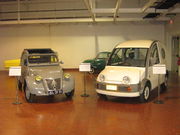

The design of the 1989 Nissan S-Cargo (a play on the word "Escargot") was directly inspired by the appearance of the tiny French Citroën 2CV Fourgonnette or small truck/delivery van, even including the single spoke steering wheel. The 2CV was relatively popular in Japan at this time. The car was introduced at the Tokyo Motor Show, along with the Nissan Figaro, and was built from 1989-1992 by Pike Factory for Nissan. It was based on the K10 Nissan Micra. Approximately 12,000 were manufactured. All S-Cargos are right hand drive. While initially marketed only in Japan, S-Cargos have spread as grey market import vehicles.
The Chrysler CCV or Composite Concept Vehicle developed in the mid-1990s is a concept car developed to illustrate new means of construction suitable to developing nations. The car is a tall, fairly roomy four-door sedan, of modest dimensions. The designers at Chrysler note they were inspired to create a modernised Citroën 2CV.
The company Sorevie of Lodève was building 2CVs until 2002. The cars were built from scratch using mostly new parts. But since the 2CV no longer complied with safety regulations, the cars were sold as second-hand cars using chassis and engine numbers from old 2CVs.
The 2CV-Méhari Club Cassis also reconditions the 2CV and the Citroën Méhari. Recently they entered a 2CV prototype in the Paris-Dakar Rally; this was a four-wheel drive, twin engine car (like the 2CV Sahara) powered by two 602 cc engines, the traditional one in the front and an engine in the rear boot space.[34]
The long running 2CV circuit racing series by The Classic 2CV Racing Club continues to be popular in the UK.
Auto Express reported in a May 2007 news item that a 2CV concept similar in appearance to the 2005 Evoque would make an appearance in 2009, with Citroën likely to position its modern interpretation of the car against premium rivals such as the Mini.[35]
Styling of the Citroën C3 and Pluriel included motifs reminiscent of the 2CV design.
In 2009, Citroën showed in the 2009 Frankfurt Motor Show the Revolte Concept, whose design was inspired by 2CV.
Models
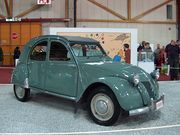
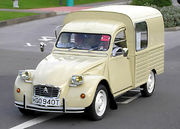
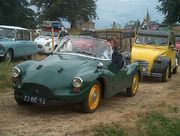
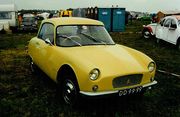
Standard Saloon
- A (1948-?)
- AZ
- AZAM
- AZL
- AZKA (2CV6, ?-1990)
- AZKB (2CV4)
Utility
- AU
- AZU, AZU 250
- AK 350
- AK 400, AKS 400
- AYCD (Acadiane)
Cabriolet (Radar)
Robert Radar designed a fibreglass body on the chassis of a 2CV in 1956 and built a few prototypes in his Citroën Garage in Liège, Belgium. Citroën Belgium was enthusiastic about this model and decided to produce it as an official Citroën 2CV in its Forest (near Brussels) factory. They manufactured about 50 bodies and added the model called 2CV "Radar" on the price list. They were assembled on order, but in 1958 and 1959, only 25 were sold and production ceased. The remaining bodies were destroyed later. There are five or six of them left, one in the Netherlands and four or five in Belgium.
Coupé (Bijou)
The Bijou was built at the Citroën factory in Slough, UK in the early 1960s. It was a two-door fibreglass-bodied version of the 2CV designed by Peter Kirwan-Taylor. The design was thought to be more acceptable in appearance to British consumers than the standard 2CV. Incorporating some components from the DS (most noticeably the single-spoke steering wheel, and windscreen for the rear window), it did not achieve market success, because it was heavier than the 2CV and still used the 425 cc engine and so was even slower, reaching 100 km/h (62 mph) only under favourable conditions. It was also more expensive than the Austin Mini, which was more practical. Only 207 were built.
Four-wheel drive
One novel model was the 2CV Sahara, a four-wheel drive (4x4) car, equipped with two engines (12 hp each), each one having a separate fuel tank.[36] One was mounted in the front driving the front wheels and one in the back driving the rear wheels. A single gearstick, clutch pedal and accelerator were connected to both engines. It was originally intended for use by the French colonies in Northern Africa. As well as a decreased chance of being stranded, it provided four-wheel drive traction with continuous drive to some wheels while others were slipping because the engine transmissions were uncoupled. Therefore it became popular with off-road enthusiasts. Between 1958 and 1971, Citroën built 694 Saharas, but only 27 are known to exist today. The top speed was 65 km/h (40 mph) on one engine, but this increased to 105 km/h (65 mph) with both engines running.
British journalist Paul Walton flew to Israel to drive one of the 27 examples left, in the desert for the April 2000 issue of Classic Cars magazine.
The Méhari was also built as a 4x4, but with only one engine.
Various 4x4 conversions were built by independent constructors, such as Marc Voisin, near Grenoble, some from a Méhari 4x4 chassis and a 2CV body. In the UK, Louis Barber builds single engined four wheel drive 2CVs. In the late 1990s, BBC Top Gear tested one against a Landrover Defender off road. The 2cv won.
Although the terminology is sometimes confused, 2CV 4x4 generally refers to these models, whereas 2CV Sahara refers to the two-engined Citroën vehicle.
Another very different double front ended, four wheel drive (but not at the same time), 2CV the 1952 Citroën Cogolin was built for the French Fire Service - The Sapeur-Pompiers.
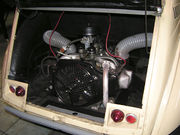
Sahara rear engine bay
|

Citroën Méhari (2WD shown, 4WD has bonnet mounted spare wheel)
|
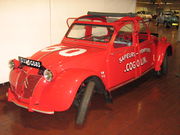
1952 Citroën Cogolin
|
Coachbuilt 2CV Cabriolet (using a modified 2CV shell)
Two examples of these are the German Hoffmann[37] and the French Azele.
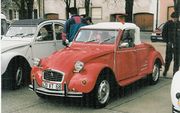
Hoffmann 2cv Cabriolet
|

Azelle Cabriolet
|
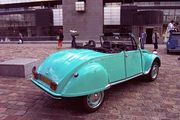
Azelle Cabriolet Rear
|
|
|
|

|
Boot Extensions
Some late model owners fitted "hunchbacks", an extension to the boot. This used the original boot lid, but in a horizontal position with the extension underneath, unlike the 1950s equivalent, which had a curved boot lid reminiscent of a post-war "big boot" Traction Avant.
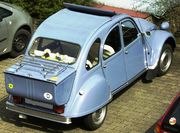
1970s/80s style boot extension
|
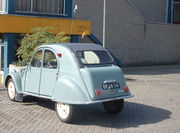
1950s style boot extension
|
Complete knock down (CKD) locally built cars
The Greek market Citroën Pony[38] and African market Citroën FAF [39] and Baby-Brousse[40] were flat-panelled Mehari type, 2CV based utility cars, built from kits in small low tech assembly plants. There was widespread production of similar 2CV-based vehicles in a large number of countries, including Iran[41] (Baby-Brousse, Jyane-Mehari), Vietnam (Dalat),[42] Chile (Yagan),[18] Belgium (VanClee), Spain, Portugal and others.
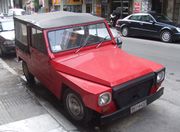
Citroën Pony
|

Citroën FAF
|
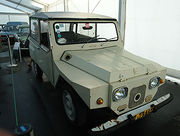
Citroën Baby-Brousse
|
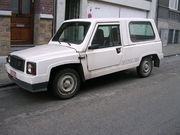
Belgian Vanclee Mungo
|
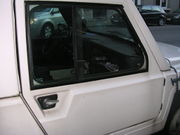
Vanclee Mungo Side
|
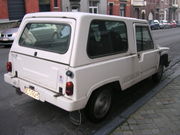
Vanclee Mungo Rear
|
Kit cars and Specials
The 2CV's availability, platform chassis construction, low cost and propensity to rust make it an ideal donor car for a special or kit car. Examples of 2CV-based kit sports cars include the Pembleton, BlackJack Avion and the Lomax from Britain, and Burton and Patron from the Netherlands. Most are also available as three wheelers (single wheel at the rear), like an early Morgan sports car. Some have been fitted with larger air-cooled twin cylinder motorcycle engines. For transportation purposes, some saloon models were rebuilt into vans using glassfibre reconstructions of corrugated 2CV Fourgonnette rear box sections. The 'Bedouin'[43] was a flat panel wooden bodied kit car, that was a spin off from the ill-fated 'Africar'[44] project. It had similarities in looks, to the Citroën Pony and Citroën FAF, CKD locally built cars.
|
Lomax
|
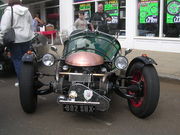
Pembleton
|
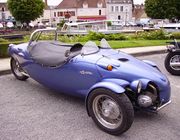
Blackjack Avion Front/Side
|
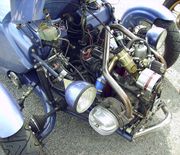
Blackjack Avion engine
|
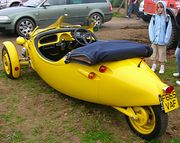
Blackjack Avion rear
|
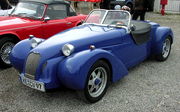
Burton
|

Le Patron
|

'Semi Citroën 2CV' Special
|
Film appearances
- A yellow Citroën 2CV6 was driven by James Bond (Roger Moore) in the 1981 film For Your Eyes Only as he and Melina Havelock (Carole Bouquet) escaped from henchmen of Aristotle Kristatos (Julian Glover) in the Spanish highlands.[45]
- Le Corniaud, 1965
- Le Gendarme de Saint-Tropez, 1964
- American Graffiti, 1973. Richard Dreyfuss drives a Deux Chevaux in this classic American car movie.
- An orange 1974 Citroën 2CV was driven by Fred Randall (Harland Williams) in the 1997 movie RocketMan.
- Les Diaboliques (1952) : la 2CV fourgonnette de 1952 (tout premier modèle) sert au transport du cadavre.
- Le Corniaud (1964) : célèbre scène de dislocation d'une 2CV avec Louis de Funès et Bourvil : « Qu'est ce qu'y a, qu'est ce qu'y a.. oh ben, elle va marcher beaucoup moins bien ! Forcément... ».
- Les films de la série du Gendarme de Saint-Tropez (à partir de 1964) : C'est la voiture de la religieuse, les gendarmes se déplaçant en Méhari. De truculentes courses poursuite.
- Ne nous fâchons pas (1966) : mémorable course poursuite entre le Type H et la 2CV des méchants britanniques qui finit sur le pilier central d'un Viaduc effondré. La scène fut tournée quelques jours avant la destruction programmée du pilier. Le budget du film ne permettait d'aller rechercher la 2CV qui a fait le grand plongeon lors du dynamitage du pilier.
- Alexandre le bienheureux (1967) : la voiture de « la Grande » est une 2CV export de 1967. Le klaxon n'est cependant pas d'origine.
- Quelques messieurs trop tranquilles (1972) de Georges Lautner : utilisation d'une 2CV camionnette par Jean Lefebvre.
- Les Valseuses (1973) : Patrick Dewaere et Gérard Depardieu volent une 2CV dans un champ, qui ne démarre pas de suite et se trouve menacée par la moissonneuse du paysan hors de lui.
- American Graffiti (1973) : elle est le véhicule de Curt Henderson (Richard Dreyfuss), ses copains roulant tous en Américaines.
- Cocorico Monsieur Poulet (1974) de Jean Rouch : un road movie au Niger en 2CV déglingué.
- Apocalypse Now (1979) : apparition très furtive sur un ponton avant explosion sous une bombe.
- Rien que pour vos yeux (1981) : avec Carole Bouquet et Roger Moore, en James Bond, au volant. Cela sera l'occasion de la parution du modèle de série limité: 2Cv 007.
- "Joyeuses Pâques" (1984) de Georges Lautner : avec Jean-Paul Belmondo, Marie Laforêt et Sophie Marceau. Une 2CV verte se fait tamponner par la Fiat Uno de Belmondo et finit à cheval sur un rail de sécurité.
- Scout toujours (1985) de Gérard Jugnot : utilisation d'une 2CV camionnette.
- Full Metal Jacket (1987) : apparition d'une 2CV grise en arrière plan, tournant continuellement en rond (40″).
- Good Morning, Vietnam (1988) : une 2CV rouge, sans vitre de custode.
- Les Visiteurs (1992) : le cuisinier du Courtepaille est jeté en l'air par Godefroy de Montmirail et atterrit sur une 2CV verte.
- Proposition indécente (1992) : elle est la voiture de Demi Moore.
- Vers la révolution en 2 CV (2001) : en 1974, Marco, Victor et Claire quittent Paris à bord d'une 2CV destination Lisbonne. La ville vient d'être libérée de la dictature.
- Antitrust (2001) : une 2CV Charleston conduite par Claire Forlani.
- Spy Game (2001) : Catherine McCormack conduit une 2CV bleue dans les rues de Beyrouth.
- Les Triplettes de Belleville (2003) film d'animation de Sylvain Chomet, où les véhicules des méchants gangsters, sont des 2CV au capot immense.
- Final Cut (2004) avec Robin Williams, où une 2CV blanche apparaît en arrière plan lors d'un Flash back.
- Destination finale à la fin du film les protagonistes se retrouvent à Paris et une 2CV est garée en face de la terrasse du troquet où ils sont assis.
- Michel Vaillant quand la voiture de course se retrouve sur l'autoroute, une 2CV est doublée.
- Louis la Brocante car la mère religieuse a une 2CV.
Notes
- ↑ 1.0 1.1 Citroën: Automotive Industry Factsheet
- ↑ 2.0 2.1 2.2 Compiled by R.M. Clarke. Citroën 2CV Ultimate Portfolio. p. 13. ISBN 1 85520 4266.
- ↑ L.J.K. Setright. Drive On!: A Social History of the Motor Car. ISBN 978-1862076983.
- ↑ Nick Larkin (July 1997). "Snails of Woe? 2CV Buyers Guide". Practical Classics Magazine.
- ↑ Clarke, 2CV Ultimate Portfolio p. 210
- ↑ John, Honest (2004-01-31). "Buyers' guide: Citroen 2CV". Telegraph. http://www.telegraph.co.uk/motoring/2726714/Buyers-guide-Citroen-2CV.html. Retrieved 2009-08-21.
- ↑ Compiled by R.M. Clarke. Citroën 2CV Ultimate Portfolio. ISBN 1 85520 4266.
- ↑ "The New York Times - AUTOS ON FRIDAY/Collecting; 50 Years of the 2CV's Joie de Vivre". June 12, 1998. http://www.nytimes.com/1998/06/12/automobiles/autos-on-friday-collecting-50-years-of-the-2cv-s-joie-de-vivre.html. Retrieved 2009-08-20.
- ↑ Compiled by R.M. Clarke. Citroën 2CV Ultimate Portfolio P.135. ISBN 1 85520 4266.
- ↑ "Not und Spiele: Die 50er Jahre...". Auto Motor u. Sport Heft 13 1996: Seite 58–65. 14 June 1996.
- ↑ Philip Chatfield (04/03). 2CVGB Members Handbook P.2-9-1.
- ↑ "The Car's the Star - Citroen 2cv". The Car's the Star. 1996.
- ↑ "The Car's the Star - Citroen 2cv". The Car's the Star. 1996.
- ↑ "The Car's the Star - Citroen 2cv". The Car's the Star. 1996.
- ↑ "The Car's the Star - Citroen 2cv". The Car's the Star. 1996.
- ↑ 16.0 16.1 1966 Citroen 2CV Charleston
- ↑ "'Piano Man' Is 'Smashup Man' Again". CBS News. 2004-04-26. http://www.cbsnews.com/stories/2004/04/26/entertainment/main613694.shtml. Retrieved 2009-05-02.
- ↑ 18.0 18.1 "Fabricados en Chile 2 - Yagán". http://www.citroenet.org.uk/foreign/latin-america/chile/yagan.html. Retrieved 2010-01-07.
- ↑ "Father of 'Black Power' Remembered". Interchange.org. http://www.interchange.org/kwameture/AP112298.html. Retrieved 2009-05-02.
- ↑ "Citroën 2CV etc.1". citcity.citroen1.info. http://citcity.citroen1.info/2CV/2cv-etc1.htm#jian. Retrieved 2007-12-01.
- ↑ "French Woodies - After 1949". oldwoodies.com. http://www.oldwoodies.com/gallery-french5.htm. Retrieved 2007-12-01.
- ↑ "Fabricados en Chile - 2CV Citroneta". http://www.citroenet.org.uk/foreign/latin-america/chile/chile.html. Retrieved 2010-01-07.
- ↑ "Argentinian Citroëns". www.citroen.mb.ca. http://www.citroen.mb.ca/citroenet/foreign/latin-america/argentina/argentina2.html. Retrieved 2008-05-28.
- ↑ "Fabricados en Argentina". http://www.citroenet.org.uk/foreign/latin-america/argentina/argentina1.html. Retrieved 2010-01-07.
- ↑ "All about: 2CV suspension". http://www.international2cvfriends.com/forum/viewtopic.php?f=7&t=485&sid=c7c1f98ff729e6aa43fcc6342dbe12cd. Retrieved 2009-10-30.
- ↑ "The 2c.v. 375c.c. CITROEN - Unorthodox Suspension". MOTOR magazine. September 17, 1950.
- ↑ "The Tin Snail". Channel 4 - Equinox. 1986.
- ↑ "The Car's the Star - Citroen 2cv". The Car's the Star. 1996.
- ↑ [1]
- ↑ Compiled by R.M. Clarke. Citroën 2CV Ultimate Portfolio P.208. ISBN 1 85520 4266.
- ↑ Citroën-Neuilly Headquarters ref.91MA-JCV/SR, 14.11.1991
- ↑ Planete 2cv n° 67 & 69
- ↑ L'Alsace, 24.11.98 / Citropolis HS n°3 / LVA, March 1988 and n° 91/36 & 91/38 / 2cv Magazine n° 74 / Jacques Wolgensinger, personal correspondence 01.05.1996 / .
- ↑ "Le Dakar 2005". takla-makane.com. http://www.takla-makane.com/pages/dakar/dakar-histo.htm. Retrieved 2007-12-01. (French)
- ↑ "Citroen's 2CV is back!". autoexpress.co.uk. http://www.autoexpress.co.uk/news/autoexpressnews/208391/citroens_2cv_is_back.html. Retrieved 2007-12-01.
- ↑ Motor Sport, February 1963, Page 102.
- ↑ cite web|url=http://www.hoffmann2cv.com
- ↑ "Namco Pony Citroën". http://www.citroenet.org.uk/foreign/greece/pony-1.html. Retrieved 2010-01-07.
- ↑ "FAF Facile à Fabriquer, Facile à Financer (Easy to build, easy to fund)". http://www.citroenet.org.uk/foreign/faf/faf01.html. Retrieved 2010-01-07.
- ↑ "Baby Brousse". http://www.citroenet.org.uk/foreign/baby-brousse/index.html. Retrieved 2010-01-07.
- ↑ "Citroën Saipac 2CV, Jiane Sedan, Jiane Pickup and Mehari". http://www.citroenet.org.uk/foreign/iran/jiane/jiane.html. Retrieved 2010-01-07.
- ↑ "Dalat the Vietnamese Baby Brousse". http://www.citroenet.org.uk/foreign/vietnam/dalat.html. Retrieved 2010-01-07.
- ↑ "2 CV Bedouin". http://www.citroenet.org.uk/foreign/bedouin/bedouin.html. Retrieved 2010-01-07.
- ↑ "Africar". http://www.citroenet.org.uk/foreign/africar/africar.html. Retrieved 2010-01-07.
- ↑ "Citroën 2CV 6 Club in "For Your Eyes Only, 1981"". IMCDb.org. http://www.imcdb.org/vehicle_2024-Citroen-2CV-6.html. Retrieved 2010-04-30.
External links
- Deux Chevaux Club of Great Britain (2CVGB)
- The Classic 2CV Racing Club - has been racing the iconic French 2CV for 20 years, providing close, exciting racing and a friendly atmosphere, while keeping costs to a minimum.
- Probably the best 2CV news and lifestyle website in the English language.-
- Find out all about the 2CV! Major French website. -
- 2CV directory - The 2CV directory aims to be the biggest, best and most complete collection of everything 2CV: websites, articles, stories, contacts and more.
- Cats Citroen Net 2CV - History, Buyer's/Owners's Guides, Restoration, Modifying, Codes/Serial Numbers, Reference, Photos
- Greater New York Citroen Velosolex Touring Club
- Citroën A Series Index Page Citroën enthusiasts site.
- garage2cv - Citroën A Series Webzine (Germany)
- Lottie the 2CV
- The only museum dedicated to the 2CV (France)
- 2CV travel, stories and video
 Media related to Citroën 2CV at Wikimedia Commons
Media related to Citroën 2CV at Wikimedia Commons
| Type | 1950s | 1960s | 1970s | |||||||||||||||||||||||||||||||||||||
| 0 | 1 | 2 | 3 | 4 | 5 | 6 | 7 | 8 | 9 | 0 | 1 | 2 | 3 | 4 | 5 | 6 | 7 | 8 | 9 | 0 | 1 | 2 | 3 | 4 | 5 | 6 | 7 | 8 | 9 | |||||||||||
| Economy car | 2CV | |||||||||||||||||||||||||||||||||||||||
| Off-roader | Méhari | |||||||||||||||||||||||||||||||||||||||
| Supermini | LN / LNA | |||||||||||||||||||||||||||||||||||||||
| Dyane | ||||||||||||||||||||||||||||||||||||||||
| Ami | Visa | |||||||||||||||||||||||||||||||||||||||
| Small family car | GS | |||||||||||||||||||||||||||||||||||||||
| Large family car | 11 CV | ID / DSpécial / DSuper | ||||||||||||||||||||||||||||||||||||||
| Executive car | 15 CV | DS | CX | |||||||||||||||||||||||||||||||||||||
| Grand tourer | SM | |||||||||||||||||||||||||||||||||||||||